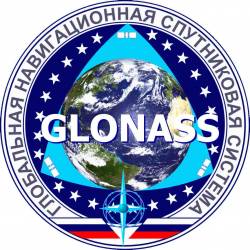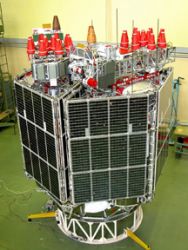The launch of a GLONASS constellation next-generation K satellite is scheduled for October, announced Nikolai Testoyedov, general director of the Reshetnev Information Satellite Systems Company. An exact date will be set by a state commission.
Developed by ISS Reshetnev and first launched in February 2011, the third-generation K satellite is a substantial improvement over the previous GLONASS-M second-generation space vehicles, with a longer lifespan and better accuracy.
In November 2014, the second and supposedly last GLONASS-K1 development satellite was placed in orbit. Shortly thereafter, Testadoyoev stated that because of Western sanctions that limited the supply of radiation-resistant electronics, Russia decided to launch nine additional GLONASS-K1 as fleet replacements while finishing the GLONASS-K2 design. However, all satellites launched since then have been the older M design.
ISS Reshetnev is now manufacturing nine Glonass-K satellites and also Glonass-K2 space vehicles and is carrying out experimental design work on modifying Glonass-K2s. It is also starting work on GLONASS-VKK (highly elliptical space system) under a new program that will be in effect in 2020-2030, Testoyedov added.
In the coming years, Russia will launch Glonass-K2 versions fully made of domestic electronic components, Testoyedov said. In 2014 when the U.S. placed export sanctions on Russia, GLONASS satellites were half-made of imported electronic components — 85% of those imported were produced in the U.S.
“We are taking measures to ensure that the share of imported electronic components falls from 50% as was the case in 2014 to 12% by 2025 (these are either available or purchased components) and from 2026 Glonass-K2 satellites will fly with the 100% Russian components base,” Testoyedov said.
GLONASS-K is the first unpressurised GLONASS satellite: its components can operate in a vacuum. Due to this, the satellite’s mass has been substantially reduced. The new satellite has an operational lifetime of 10 years, three years longer than that of GLONASS-M.
GLONASS-K will transmit the legacy FDMA signals, 2 military and 2 civilian, in the L1 and L2 bands, and additional civilian CDMA signals will be transmitted in the L1, L2, L3 and L5 bands, becoming interoperable with Galileo and GPS.
Ground Station Setting Up in Brazil
A new GLONASS reference station will begin operations in Belem, in the state of Para in Brazil. “This is the seventh non-request measuring station in the structure of the foreign segment of the GLONASS measuring stations’ network being set up by the Precision Instrument-Making Systems as part of the Signal experimental design work,” Roscosmos said in a statement.
The measuring station of the SM-Glonass system is designed to continuously monitor the signals of the GLONASS, GPS, Galileo, Compass and QZSS navigation systems. The station is also required for controlling the reliability parameters of GLONASS navigation signals.
A fifth non-request measuring station of the Glonass satellite navigation system was due to begin its operation in Brazil at the end of this year, in the country’s north. Two stations were installed in Recife (the capital of Brazil’s northeastern state of Pernambuco) and Santa Maria (in the southern state of Rio Grande do Sul). Two stations of different types are operating in the Federal University of Rio de Janeiro. In addition to fulfilling their main task, they can also be used by Brazilian scientists for their own research.






